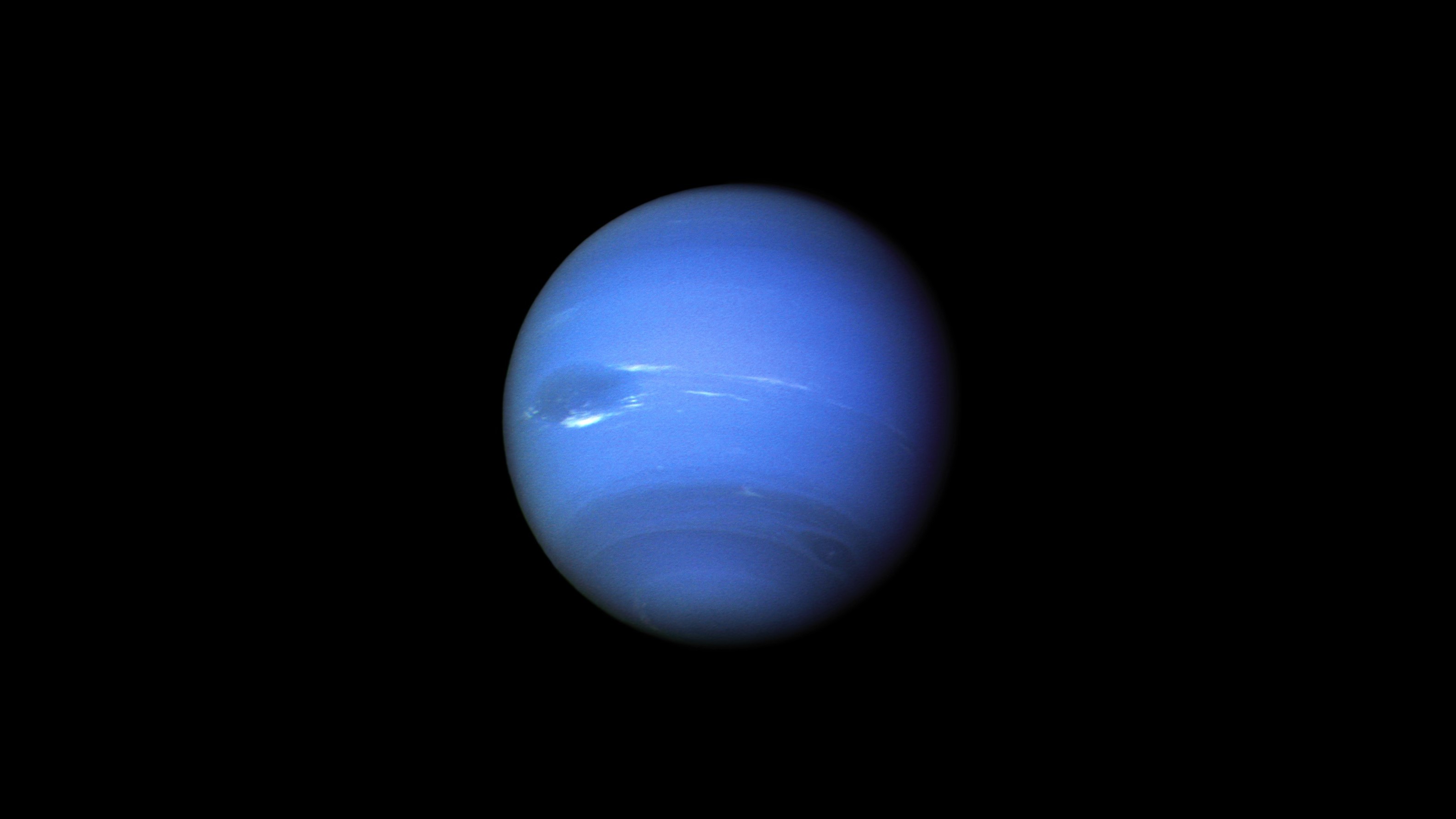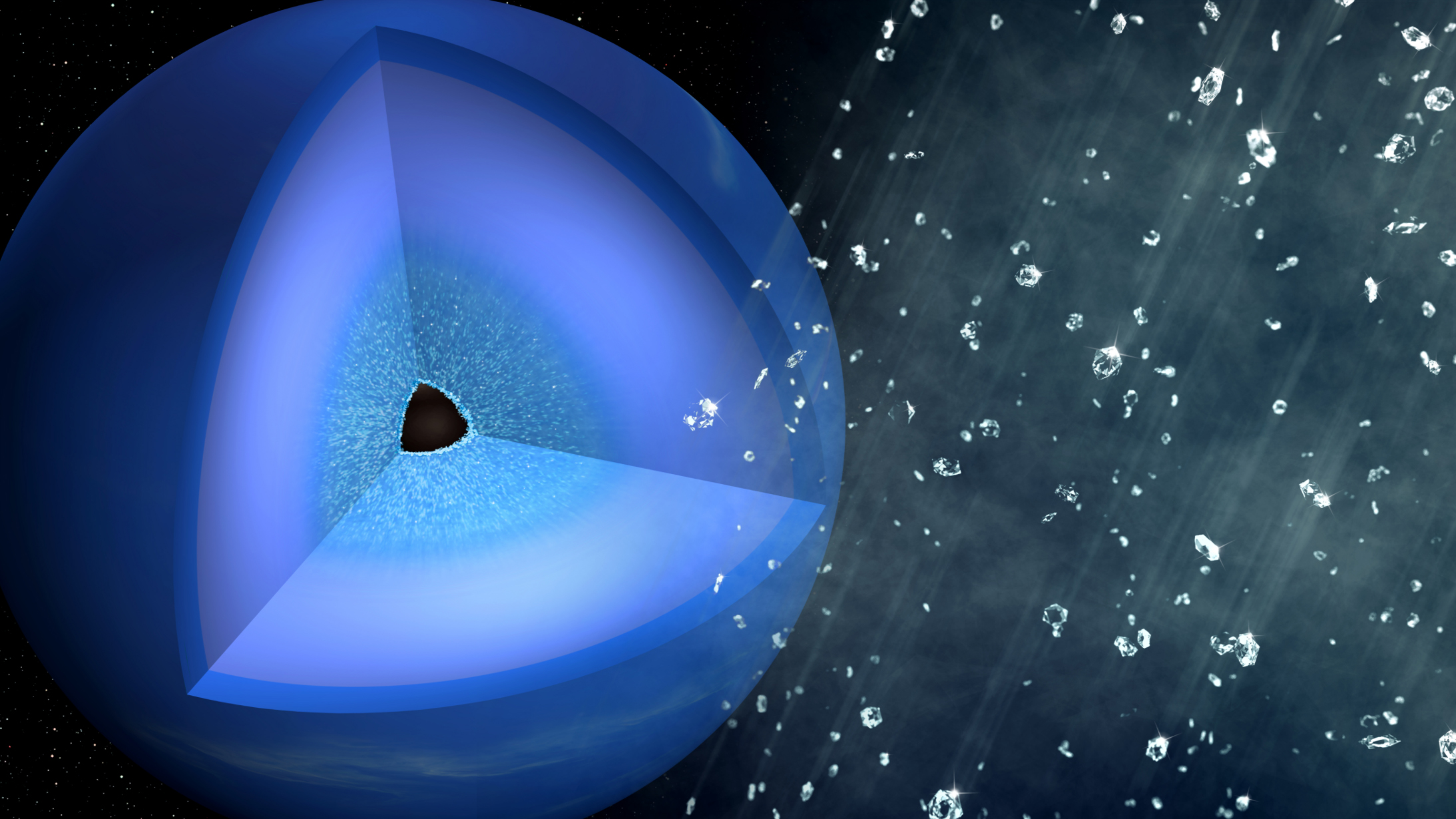Neptune: The farthest planet from our sun
Neptune is one of two "ice giants" in the solar system.

Neptune is the farthest planet from the sun and one of two "ice giants" in our solar system. The cold, blue planet is about 30 times farther away from the sun than Earth and takes around 165 Earth years to complete a single orbit around our star. Neptune spins around its axis quicker than Earth, so a day on Neptune is only around 16 Earth hours.
When was Neptune discovered?
Scientists discovered Neptune in 1846, after they conducted orbit calculations for Uranus that indicated there was an unknown planet affecting Uranus's gravity, according to the Natural History Museum in London, U.K. Neptune isn't visible to the naked eye, but the researchers were able to confirm the planet's existence using a telescope. Astronomers had previously spotted Neptune through telescopes as early as 1612, but hadn't identified it as a planet, according to NASA.
Only one of Earth's probes has ever reached Neptune — Voyager 2, which snapped the first images of the blue planet in 1989 on its way out of the solar system. Neptune appears blue, or blue-green, because of the methane in its atmosphere, according to Smithsonian National Air and Space Museum in Washington D.C. The name Neptune comes from the Roman god of the sea of the same name, according to Cool Cosmos, a website run by the Infrared Processing and Analysis Center at the California Institute of Technology.
Related: Mercury probe snaps stunning photos of our planet during Earth flyby
How long would it take to get to Neptune?
Neptune is the eighth planet from the sun and the final planet in the solar system, since scientists demoted Pluto from full planetary status to dwarf planet in 2006. Neptune is also the farthest planet in the solar system from Earth and orbits at a distance of between 2.7 billion miles (4.3 billion kilometers) and 2.9 billion miles (4.7 billion km) from our planet, depending on where the two planets are in their orbits, Live Science's sister site Space.com previously reported. The Voyager 2 probe took 12 years to reach Neptune, according to NASA's Jet Propulsion Laboratory. However, the probe was traveling at an average speed of 42,000 mph (about 68,000 km/h) — much faster than humans have ever traveled.
How cold is Neptune?
The temperature in Neptune's atmosphere is around minus 373 degrees Fahrenheit (minus 225 degrees Celsius), according to the National Air and Space Museum. Being farther away from the sun than Uranus, you might expect Neptune to be colder, but the two planets are about the same temperature. Neptune emits more than twice as much heat as it absorbs from the sun, similar to Jupiter and Saturn, Live Science previously reported.
"The extra heat source on Neptune [and Jupiter and Saturn] is largely due to gravitational contraction," Joshua Tollefson, a data scientist formerly at the University of California, Berkeley, told All About Space magazine in 2019. "As the planet slowly gravitationally contracts, the material falling inward changes its potential energy into thermal energy, which is then released upwards out of the planet."
Get the world’s most fascinating discoveries delivered straight to your inbox.
Neptune also has the strongest winds in the solar system, which can reach 1,200 mph (1,9301 km/h), according to Cool Cosmos. Seasons on Neptune last about 40 years each, and the planet's southern hemisphere is currently in the Earth equivalent of summer. However, a 2022 study published in The Planetary Science Journal used infrared images of the planet to determine that despite entering summer in 2005, Neptune's global temperature actually dropped by 14.4 F (8 C) between 2003 and 2018. The researchers speculated that the plummeting temperatures in Neptune's atmosphere could be caused by either an unidentified element, extreme weather or changes in solar radiation.
"I think Neptune is itself very intriguing to many of us because we still know so little about it," study lead author Michael Roman, an astronomer at the University of Leicester in the U.K., said in a statement at the time. "This all points towards a more complicated picture of Neptune’s atmosphere and how it changes with time."
Related: The sun has blasted Mercury with a plasma wave
What is Neptune made of?
Neptune is mostly composed of water, ammonia and methane and could be hiding a "super hot" ocean under its chilly clouds, according to NASA. The planet doesn't have a solid surface, but does have a solid core like Earth. Along with Uranus, Neptune is called an "ice giant." The name distinguishes Neptune from the "gas giants" of Jupiter and Saturn because Neptune and Uranus have more ice-forming molecules, according to the Planetary Society.
Neptune and Uranus are famous for their "diamond rain." This is possible because the high atmospheric pressure on these planets — which is more than 200,000 times what it is on Earth — breaks up methane in the atmosphere to release carbon. The carbon then groups together in long chains to form crystalline patterns like diamonds. These "diamonds" sink through the mantle, where they are vaporized by even more extreme conditions — the innermost regions of these planets’ mantles likely hit around 12,140 F (6,727 C) with pressures 6 million times that of Earth — before floating back up for the process to repeat, Live Science previously reported.
Does Neptune have moons?
Neptune has 14 moons and at least five rings. Triton, the largest of Neptune's moons, orbits in the opposite direction to the planet's spin. This reverse orbit indicates that Triton hasn't always been paired with Neptune, and scientists think it was pulled into Neptune's gravity from the Kuiper Belt millions of years ago, according to NASA.
Nereid, another of Neptune's moons, has an even more peculiar orbit, making it one of the weirdest moons in the solar system. This moon can swing in close to Neptune at a distance of 870,000 miles (1.4 million km) and swing out as far as 6 million miles (9.7 million km). One reason for this strange lunar orbit could be that when Triton was pulled toward Neptune, it threw off the orbits of Neptune's existing moons and sent most of them whizzing off into space. However, Nereid could be an original moon that clung on to the edge of Neptune's gravity to shape its current orbit.
Related: Neptune's wobbling moons are locked in a never-before-seen orbital dance
Additional resources
To view images of Neptune taken by the Voyager 2 probe, check out NASA's Jet Propulsion Laboratory website. To learn more about diamond rain on Neptune and Uranus, watch this short YouTube video by astrophysicist and Live Science contributor Paul M. Sutter. For a children's book on Neptune, check out "The Secrets of Neptune" (Capstone Press, 2015).
Editor's note: This article was updated on Wednesday, May 25 at 9:00 a.m. EDT to note that Neptune, not Mercury, was analyzed in a 2022 study in The Planetary Science Journal.
Originally published on Live Science.

Patrick Pester is the trending news writer at Live Science. His work has appeared on other science websites, such as BBC Science Focus and Scientific American. Patrick retrained as a journalist after spending his early career working in zoos and wildlife conservation. He was awarded the Master's Excellence Scholarship to study at Cardiff University where he completed a master's degree in international journalism. He also has a second master's degree in biodiversity, evolution and conservation in action from Middlesex University London. When he isn't writing news, Patrick investigates the sale of human remains.
 Live Science Plus
Live Science Plus






